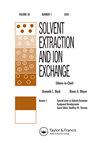结合亲脂邻菲罗啉Carboxamide和亲水二乙醇酰胺以提高相邻轻镧系元素的分离系数
IF 2.1
4区 化学
Q3 CHEMISTRY, MULTIDISCIPLINARY
引用次数: 0
摘要
本文章由计算机程序翻译,如有差异,请以英文原文为准。
Combining a Lipophilic Phenanthroline Carboxamide and a Hydrophilic Diglycolamide to Increase the Separation Factors of Adjacent Light Lanthanides
ABSTRACT The combination of two neutral CHON reagents, a lipophilic phenanthroline dicarboxamide and a hydrophilic diglycolamide, resulted in a synergistic separation of adjacent light lanthanides in nitrate medium as the ligands present a reversed lanthanide selectivity. Separation factors higher than 7 were obtained for the pair Pr/Nd, which is one of the highest values reported in the literature.
求助全文
通过发布文献求助,成功后即可免费获取论文全文。
去求助
来源期刊
CiteScore
4.40
自引率
5.00%
发文量
15
审稿时长
8.4 months
期刊介绍:
Solvent Extraction and Ion Exchange is an international journal that publishes original research papers, reviews, and notes that address all aspects of solvent extraction, ion exchange, and closely related methods involving, for example, liquid membranes, extraction chromatography, supercritical fluids, ionic liquids, microfluidics, and adsorption. We welcome submissions that look at: The underlying principles in solvent extraction and ion exchange; Solvent extraction and ion exchange process development; New materials or reagents, their syntheses and properties; Computational methods of molecular design and simulation; Advances in equipment, fluid dynamics, and engineering; Interfacial phenomena, kinetics, and coalescence; Spectroscopic and diffraction analysis of structure and dynamics; Host-guest chemistry, ion receptors, and molecular recognition.

 求助内容:
求助内容: 应助结果提醒方式:
应助结果提醒方式:


